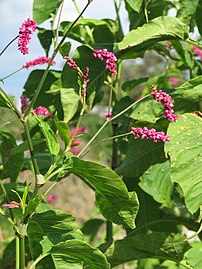Map Snapshot







13 Records
Seasonality Snapshot
Use of media featured on Maryland Biodiversity Project is only permitted with express permission of the photographer.
No images available
Source: Wikipedia
| Persicaria orientalis | |
|---|---|

| |
| In Korea | |
| Scientific classification | |
| Kingdom: | Plantae |
| Clade: | Tracheophytes |
| Clade: | Angiosperms |
| Clade: | Eudicots |
| Order: | Caryophyllales |
| Family: | Polygonaceae |
| Genus: | Persicaria |
| Species: | P. orientalis
|
| Binomial name | |
| Persicaria orientalis (L.) Spach[1]
| |
| Synonyms[1] | |
| |
Persicaria orientalis is a species of flowering plant in the family Polygonaceae,[1] known as kiss-me-over-the-garden-gate and princess-feather.[2] It was first described, as Polygonum orientale, by Carl Linnaeus in 1753. It was transferred to the genus Persicaria by Édouard Spach in 1841.[3] Its native distribution is unclear.[4] As of April 2023, Kew's Plants of The World Online lists its native distribution as ranging from the Russian far east to Indochina, Malesia and Australia.[5] It is widely cultivated and naturalized.[4]
-
Leaf
-
Stem with ochrea (sheath)
-
Inflorescence
-
In cultivation in England
References
[edit]Wikimedia Commons has media related to Persicaria orientalis.
- ^ a b c "Persicaria orientalis (L.) Spach", Plants of the World Online, Royal Botanic Gardens, Kew, retrieved 2019-05-04
- ^ Hinds, Harold R. & Freeman, Craig C., "Persicaria orientalis", in Flora of North America Editorial Committee (ed.), Flora of North America (online), eFloras.org, retrieved 2019-05-04
- ^ "Plant Name Details for Persicaria orientalis (L.) Spach", The International Plant Names Index, retrieved 2019-05-04
- ^ a b "Persicaria orientalis (L.) Spach", Germplasm Resources Information Network, Agricultural Research Service, United States Department of Agriculture, retrieved 2019-05-04
- ^ "Persicaria orientalis (L.) Spach | Plants of the World Online | Kew Science". Plants of the World Online. Retrieved 2023-04-07.




